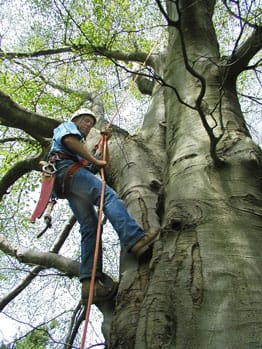Who do you call when you need someone to prune a one hundred year old, one hundred and fifty foot tall oak tree that sits ten feet away from your house? Who do you call if your favorite 80-year-old pecan is starting to decline?
A certified arborist, that’s who. Arborists are the surgeons of the tree trade as well as the physicians. They diagnose tree problems (diseases, insect infestations, and decline), implement strategies to mitigate poor tree health, and provide emergency tree care. At some time or another, everyone will need an arborist. Remember, trees are investments that can become liabilities if not cared for properly.
What does it mean to be a ‘certified’ arborist? It means the arborist has been through a rigorous training and testing process to assure that he or she meets the standards set by the International Society of Arboriculture for a qualified professional arborist.
These persons are well trained in tree health, pest management, soil fertility, assessing storm damage, cabling and bracing, and proper pruning techniques. In other words, they are specialists in the care of trees. If you were hiring a company to do any tree work at your home, I would recommend only using certified arborists. When soliciting for quotes, ask for proof of insurance and references as well. Always get three estimates. You will usually be required to sign a contract, so read it carefully.
Tree work is tough and physically demanding. Imagine spending your whole day climbing towering trees with spikes on your boots and a chainsaw attached to your belt. At first glance one might think these people are a little crazy, especially when one sees one of them walk out to the end of a limb sixty feet in the air. Crazy that is, until you realize they are always wearing safety rigging that is attached to the main trunk of the tree. The rigging is the same type used by mountain climbers. Every responsible tree person wears safety rigging, a hard hat, earplugs, and eye protection.
When an arborist does a consultation, he or she evaluates tree health and tries to recommend a plan to stop any tree decline. The arborist might recommend pruning to remove any dead wood or to shape the tree. If the tree has any unsafe branches or bad branch angles, the tree professional might cable the offending limbs. Cabling involves using heavy gauge stainless steel cable and eye bolts to secure limbs and trunks. The arborist may recommend a fertilization regime to increase the tree’s vigor and stop any decline. Trees are often fertilized using a 3-2-1 ratio liquid fertilizers injected into holes that are drilled in the soil around the tree.
If the tree is not salvageable, then the arborist will recommend removing the unhealthy tree. Often, the tree will be in a location where it cannot be felled easily. Maybe there is a structure under or near the tree or the tree is near the property line. In this case, the arborist may decide to rope the tree. Climbing the tree, the arborist ties ropes to the branches. Then the branches are cut off one by one allowing the rope to break the fall. In essence the tree is removed from the top down. The branches will be lowered down gently to workers on the ground to prevent any unwarranted damage. After removal, the company will chip the tree into mulch with a machine or haul it away. Reputable companies will leave the property only after they have cleaned up the mess and the customer is satisfied.
Trees are assets that add value to one’s property and should be cared for properly. With the help of certified arborists, homeowner’s trees will remain healthy and safe through proper fertility management and pruning. If you have need for a certified arborist, please call the Gwinnett County Extension Service for a list of local companies at (678) 377-4010.
- Herbicide Damaged Plants - September 24, 2013
- IPM in the Garden - September 24, 2013
- Leylands Get Really Big - September 24, 2013
